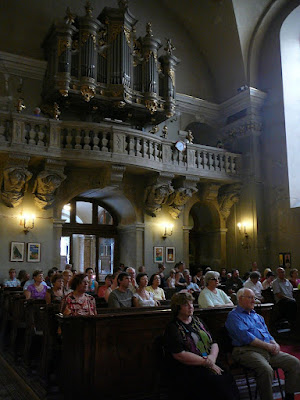
Germany’s beautiful coast-lined region of
Mecklenburg-
Vorpommern offers historic castles, museums, and local culinary specialties plus a rich music history and lots of culture. It is here that one can experience the sound of rich classical music and famous operatic arias, and a lot of this cultural richness is the legacy of one monarch’s love of performing arts.
Queen Charlotte of
Mecklenburg, consort of King George III, devoted much of her time and money to the advancement of music in this region. As a connoisseur and enthusiast of the great George
Frideric Handel, Queen Charlotte had an avid interest in all German artists and composers.
In 1764, the Queen summoned, then eight-year-old,
Wolfgang Amadeus Mozart to court in order to perform a special four-hour show to an intimate crowd of the monarch’s closest
advisors. Mozart went on to publish six sonatas in 1765, simply entitled Opus 3, which he admirably dedicated to his supporter, Queen Charlotte, on the fifth anniversary of the King’s accession.
 Johann Christian Bach
Johann Christian Bach, eleventh son of Johann Sebastian Bach, served as Queen Charlotte’s personal music master. To entertain the Queen and her court, the young Bach was often expected to play new and unrehearsed music at first sight.
The Queen not only enjoyed listening to magnificent classical works, but was also herself a talented musician. Johann Christian Bach often accompanied her as she sang various arias. She also fluently played the flute, which she once performed as Mozart provided the accompaniment. The influence of Queen Charlotte’s musical advocacy can be heard today in various forms throughout the
Mecklenburg-
Vorpommern region.
Summertime offers numerous open-air concerts, as well as Germany’s largest classical music festival.
Festspiele Mecklenburg-Vorpommern occurs from June through September, presenting more than 100 various classical music performances, in venues ranging from established concert halls and country estates, to village churches and family barns. Acts include world renowned musicians, as well as developing young talent.
 Mecklenburg
Mecklenburg-
Vorpommern is a great place for anyone who enjoys rich history, beautiful scenery, and classic music!
Photos of young Mozart, Johann Christian Bach, and Festspiele provided by Wikipedia and Ennus Photos.
 dies at Queens University of Charlotte, I received the privileged opportunity to travel as a member of the university’s Chamber Singers on tour to the
dies at Queens University of Charlotte, I received the privileged opportunity to travel as a member of the university’s Chamber Singers on tour to the 
 ced an exchange interaction with a local collegiate choir, the Angelus Choir, with whom we performed multiple joint concerts, one of which took place in their own school. Collaborating with the Angelus Choir students was by far my favorite performance of the entire trip. They guided us through town, took us out for dinner and gelato, and showed us the culture of typical Polish university students. I am proud to say that, through the wonders of Facebook, I still call many of these students my friends, and will hopefully see them again very soon.
ced an exchange interaction with a local collegiate choir, the Angelus Choir, with whom we performed multiple joint concerts, one of which took place in their own school. Collaborating with the Angelus Choir students was by far my favorite performance of the entire trip. They guided us through town, took us out for dinner and gelato, and showed us the culture of typical Polish university students. I am proud to say that, through the wonders of Facebook, I still call many of these students my friends, and will hopefully see them again very soon. 
































